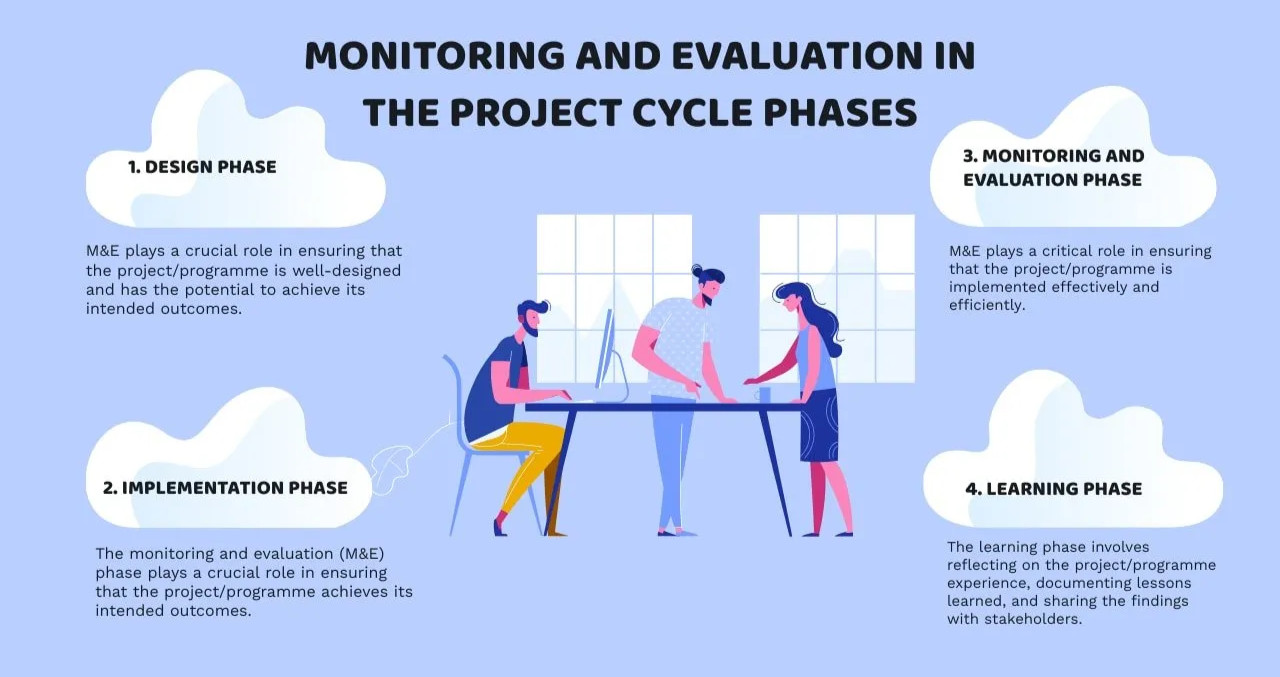
Monitoring and Evaluation (M&E) plays a crucial role in the success of development projects. It provides a structured approach to assessing progress, identifying areas of improvement, and ensuring accountability. Without a proper M&E framework, development initiatives risk inefficiency, misallocation of resources, and failure to achieve their intended impact.
Monitoring and Evaluation are interrelated yet distinct processes in project management:
ü Monitoring is the systematic tracking of project activities and progress over time to ensure alignment with objectives.
ü Evaluation is a periodic assessment of a project's relevance, effectiveness, efficiency, impact, and sustainability.
A well-executed M&E system provides real-time data, supports decision-making, and enhances learning for future projects.
1. Improves Project Effectiveness: M&E helps organizations track progress, adjust strategies, and ensure that activities lead to the desired outcomes.
2. Ensures Accountability: Development projects often involve multiple stakeholders, including donors, government agencies, and beneficiaries. M&E ensures transparency and accountability by providing evidence-based reports.
3. Enhances Learning and Adaptability: By analyzing what works and what doesn’t, M&E fosters a learning culture that allows for better decision-making in future projects.
4. Optimizes Resource Allocation: M&E helps identify inefficiencies, ensuring that resources are allocated where they generate the greatest impact.
5. Measures Impact: Evaluating the long-term effects of interventions ensures that projects lead to meaningful and sustainable change.
1. Clear Objectives and Indicators:
o Define measurable goals aligned with the project’s purpose.
o Develop SMART (Specific, Measurable, Achievable, Relevant, Time-bound) indicators to track progress.
2. Data Collection and Analysis:
o Use qualitative and quantitative data collection methods such as surveys, interviews, focus groups, and case studies.
o Employ data analysis tools to interpret results and draw actionable insights.
3. Baseline and Endline Studies:
o A baseline study assesses initial conditions before project implementation.
o An endline study compares results against the baseline to measure changes and impact.
4. Monitoring Framework:
o Regularly track inputs, activities, and outputs to ensure projects remain on course.
o Use tools like logframes (Logical Frameworks) to map project goals and indicators.
5. Evaluation Techniques:
o Conduct formative evaluations (during implementation) to identify areas for improvement.
o Conduct summative evaluations (at the project’s conclusion) to assess overall impact.
1. Theory of Change (ToC):
o A visual representation of how project activities lead to desired outcomes and impact.
o Helps stakeholders understand causal linkages between interventions and results.
2. Randomized Controlled Trials (RCTs):
o Considered the gold standard for impact evaluation.
o Compares an intervention group with a control group to measure effectiveness.
3. Quasi-Experimental Designs:
o Useful when RCTs are not feasible.
o Uses methods like propensity score matching or difference-in-differences analysis.
4. Participatory Approaches:
o Engages beneficiaries in the evaluation process.
o Methods include participatory rural appraisals and focus group discussions.
5. Cost-Benefit Analysis (CBA):
o Assesses the financial efficiency of a project by comparing costs to benefits.
o Helps in determining the return on investment (ROI).
1. Lack of Clear Indicators:
o Solution: Develop well-defined, realistic, and context-specific indicators.
2. Limited Capacity and Expertise:
o Solution: Train project staff on M&E methodologies and best practices.
3. Insufficient Data Quality:
o Solution: Standardize data collection tools and ensure rigorous data validation.
4. Resistance to M&E:
o Solution: Foster a culture of learning where M&E is seen as a tool for improvement rather than judgment.
5. Limited Funding for M&E:
o Solution: Advocate for dedicated M&E budgets within project proposals.
1. Integrate M&E from the Start:
o Design M&E frameworks at the planning stage to align with project goals.
2. Use Mixed Methods:
o Combine qualitative and quantitative approaches for comprehensive insights.
3. Engage Stakeholders:
o Involve beneficiaries, donors, and partners to ensure relevance and ownership.
4. Leverage Technology:
o Utilize mobile data collection, Geographic Information Systems (GIS), and real-time dashboards for efficient monitoring.
5. Ensure Regular Reporting and Feedback:
o Establish clear reporting mechanisms and use findings to inform decision-making.
The art of Monitoring and Evaluation is essential for measuring impact and ensuring the success of development projects. A well-structured M&E framework enhances accountability, optimizes resource use, and provides valuable insights for future initiatives. By adopting best practices, leveraging innovative methodologies, and fostering a learning culture, organizations can maximize the effectiveness and sustainability of their development interventions.

Phoenix Training Center
Typically replies in minutes